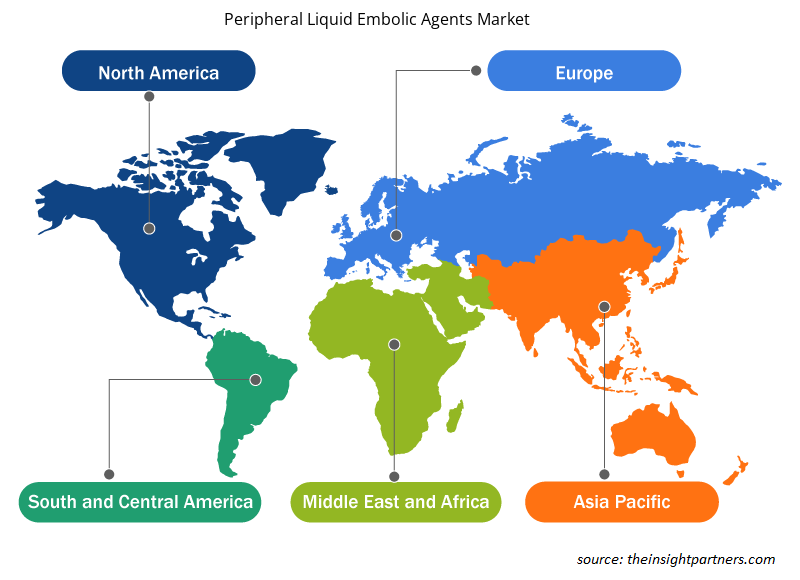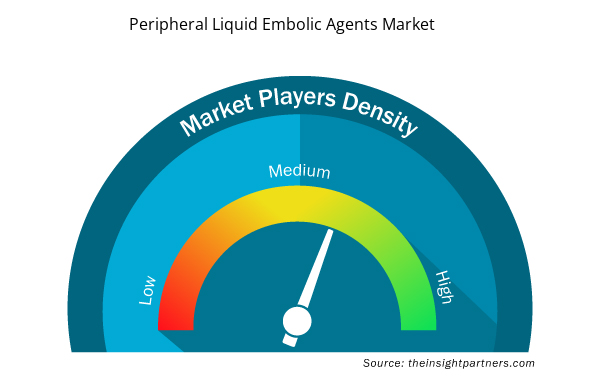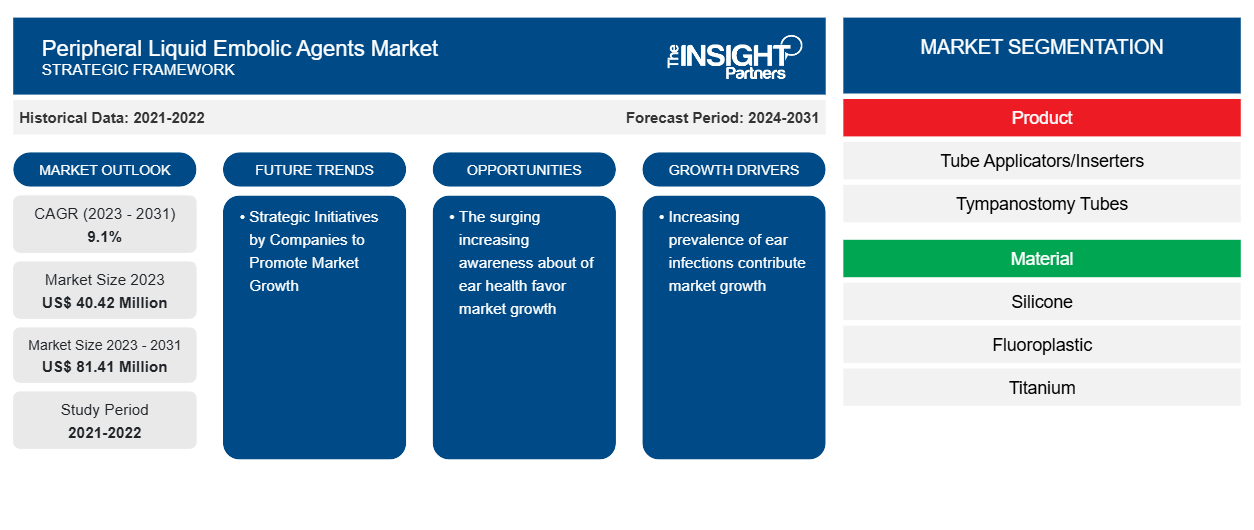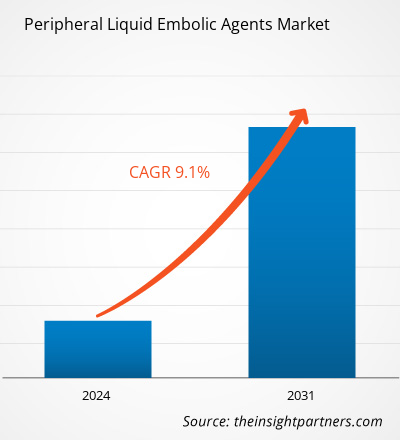La taille du marché des agents emboliques liquides périphériques devrait atteindre 81,41 millions USD d'ici 2031, contre 40,42 millions USD en 2023. Le marché devrait enregistrer un TCAC de 9,1 % au cours de la période 2023-2031. L'intérêt croissant et les développements dans les systèmes de changement de phase induits par la température et les agents emboliques déclenchés par le pH sont susceptibles d'apporter de nouvelles tendances sur le marché des agents emboliques liquides périphériques
Analyse du marché des agents emboliques liquides périphériques
Les agents emboliques liquides sont principalement utilisés dans les procédures mini-invasives, telles que l'embolisation, pour traiter les anévrismes, les malformations artérioveineuses, les tumeurs et d'autres affections. Ces agents offrent une alternative moins invasive aux méthodes chirurgicales traditionnelles et permettent aux médecins un meilleur contrôle et une plus grande précision dans la fermeture des vaisseaux sanguins tout en minimisant le traumatisme et les temps de récupération des patients. Les innovations technologiques devraient améliorer les performances des produits et favoriser une adoption plus large dans diverses applications en aval. En outre, le marché des agents emboliques liquides périphériques est en croissance en raison de l'adoption et de l'acceptation croissantes par les patients et les professionnels de la santé en raison de la prise de conscience croissante des avantages apportés par les agents emboliques liquides dans le traitement des maladies vasculaires périphériques.
Aperçu du marché des agents emboliques liquides périphériques
Les agents emboliques liquides sont utilisés pour traiter les maladies vasculaires périphériques telles que la varicocèle et l'embolisation artérielle périphérique. Le marché de ces agents est stimulé par la préférence croissante des patients et des professionnels de la santé pour les procédures mini-invasives. L'introduction des dernières technologies médicales, telles que les agents emboliques liquides, soutenue par l'augmentation des dépenses de santé à l'échelle mondiale et l'amélioration des infrastructures de santé dans les marchés émergents, stimule l'expansion du marché des agents emboliques liquides périphériques. En outre, les pratiques de remboursement favorables pour les procédures mini-invasives utilisant des agents emboliques liquides dans de nombreux pays favorisent leur acceptation et stimulent l'expansion du marché.
Personnalisez ce rapport en fonction de vos besoins
Vous bénéficierez d'une personnalisation gratuite de n'importe quel rapport, y compris de certaines parties de ce rapport, d'une analyse au niveau des pays, d'un pack de données Excel, ainsi que de superbes offres et réductions pour les start-ups et les universités.
- Obtenez les principales tendances clés du marché de ce rapport.Cet échantillon GRATUIT comprendra une analyse de données, allant des tendances du marché aux estimations et prévisions.
Facteurs moteurs et opportunités du marché des agents emboliques liquides périphériques
Incidence croissante des maladies vasculaires périphériques
Les maladies vasculaires périphériques (MVP) comprennent la maladie artérielle périphérique (MAP) et la maladie veineuse. La prévalence croissante de la MVP peut être attribuée au vieillissement de la population qui accroît la visibilité de ses différentes modalités de diagnostic et de traitement. Selon l’article « Income-Related Peripheral Artery Disease Treatment » publié dans la National Library of Medicine, plus de 200 millions de personnes dans le monde souffrent de MVP, et environ 10 % des personnes âgées de 50 ans et plus ont été touchées par la maladie en Europe occidentale et en Amérique du Nord. La prévalence de la MVP varie de 3 % chez les patients âgés de plus de 55 ans et 11 % chez les patients âgés de plus de 65 ans à 20 % chez les patients âgés de plus de 75 ans. Selon une étude publiée dans la Bibliothèque nationale de médecine intitulée « Tendances séculaires dans les schémas épidémiologiques des maladies artérielles périphériques et facteurs de risque en Chine », le nombre de personnes souffrant de maladies artérielles périphériques en Chine a augmenté de 40 % entre 2000 et 2020. En 2020, environ 41 millions d'adultes en Chine étaient touchés par la maladie artérielle périphérique. En 2020, des recherches épidémiologiques en Chine ont également révélé que la prévalence de la maladie artérielle périphérique dans la population générale âgée de 35 ans et plus était de 6 %, et que la prévalence de la maladie artérielle périphérique chez les personnes âgées de plus de 60 ans était de 15 % en Chine. On estime que plus de 30 millions de patients souffrent de maladie artérielle périphérique dans le pays.
La prévalence croissante de la maladie vasculaire périphérique est attribuée aux facteurs de risque croissants associés au diabète, au tabagisme, à l'obésité et à l'âge. En raison des changements de mode de vie malsains et de la disponibilité insuffisante des médicaments pour traiter les symptômes de la maladie vasculaire périphérique, les procédures mini-invasives utilisant des stents périphériques sont souvent le traitement standard. Les maladies cérébrovasculaires/carotidiennes, les maladies artérielles périphériques et les anévrismes de l'aorte abdominale font partie des vasculopathies périphériques les plus courantes signalées par les médecins de premier recours. Toutes nécessitent un traitement médical agressif pour prévenir des complications potentiellement graves et nécessitent une évaluation par des chirurgiens vasculaires. Les agents emboliques liquides sont généralement injectés et introduits dans les sites de malformation vasculaire à l'aide d'un cathéter guidé par imagerie à rayons X (c'est-à-dire une angiographie). Après perfusion des agents emboliques liquides, ils se transforment en un implant solide in situ, basé sur différents mécanismes, notamment la précipitation, la polymérisation et la réticulation, par des processus ioniques ou thermiques. Les agents emboliques liquides ne dépendent pas du système de coagulation du patient pour une occlusion complète et peuvent être efficaces même chez les patients souffrant d'une coagulopathie sévère. Si un cathéter ne peut pas atteindre un site de saignement, des agents liquides peuvent assurer l'embolisation distale de l'extrémité du cathéter. Des stratégies de traitement à long terme, de meilleurs résultats et des réglementations visant à réduire la mortalité cardiovasculaire sont recommandées par toutes les grandes régions, notamment la Société européenne de cardiologie (ESC), la Société européenne de chirurgie vasculaire (ESVS), l'American Heart Association (AHA) et l'American College of Cardiology (ACC). Par conséquent, la prévalence croissante des PVD stimule la croissance du marché des agents emboliques liquides périphériques.
Initiatives stratégiques croissantes des acteurs du marché
Les acteurs du marché se concentrent constamment sur le maintien de leur position de leader sur le marché en travaillant continuellement sur des initiatives stratégiques, en introduisant de nouveaux produits et en améliorant les produits existants pour élargir l'utilisation des agents emboliques liquides périphériques.
- En novembre 2023, Fluidx Medical Technology a annoncé le développement de sa plateforme d'embolisation ultra-périphérique pour les saignements, le traitement des tumeurs et d'autres applications d'embolisation proximale. Le communiqué de presse précise que la plateforme ultra est conçue pour rendre les procédures d'embolisation thérapeutique par cathéter plus sûres, meilleures et plus rapides.
- En octobre 2023, Sirtex Medical a annoncé la disponibilité commerciale du LAVA - Liquid Embolic System, un agent embolique liquide approuvé pour le traitement des saignements vasculaires périphériques. LAVA offre des options de volume et de viscosité qui optimisent la flexibilité dans le traitement des patients présentant une occlusion contrôlée du vaisseau cible. Les options de 2 ml et 6 ml du produit sont optimisées pour la vascularisation périphérique, et ses options de viscosité permettent l'embolisation distale de petits vaisseaux qui peuvent ne pas être accessibles via d'autres emboles.
- En mai 2023, Grand Pharmaceutical Group Ltd. a acquis une participation de 87,5 % dans Blackswan Vascular Inc., une société qui développe des solutions d'embolisation liquide pour les applications vasculaires périphériques. La société continue d'étendre sa présence dans le domaine des interventions contre les tumeurs.
Ainsi,les lancements de nouveaux produits basés sur des avancées et des initiatives stratégiques sont susceptibles d'offrir de nouvelles opportunités pour le marché des agents emboliques liquides périphériquesdans les années à venir.
Analyse de segmentation du rapport sur le marché des agents emboliques liquides périphériques
Les segments clés qui ont contribué à la dérivation de l’analyse du marché des agents emboliques liquides périphériques sont le type et l’application.
- Par type, le marché des agents emboliques liquides périphériques est divisé enAgents emboliques liquides polymérisants et agents emboliques liquides précipitants. En 2023, le segment des agents emboliques liquides précipitants détenait une part de marché plus importante et devrait enregistrer un TCAC plus élevé au cours de la période 2023-2031.
- En termes d’application, le marché est segmenté enEndofuites de type II, malformations, saignements et traumatismes, varices, tumeurs et anévrismes viscéraux. En 2023, le segment des endofuites de type II détenait la plus grande part du marché. Cependant, le segment des saignements et traumatismes devrait enregistrer le TCAC le plus élevé de 2023 à 2031.
Analyse des parts de marché des agents emboliques liquides périphériques par géographie
La portée géographique du rapport sur le marché des agents emboliques liquides périphériques est principalement divisée en cinq régions : l’Amérique du Nord, l’Asie-Pacifique, l’Europe, le Moyen-Orient et l’Afrique, et l’Amérique du Sud et l’Amérique centrale.
L'Amérique du Nord détient la plus grande part du marché des agents emboliques liquides périphériques. La croissance du marché régional est propulsée par l'incidence croissante des maladies vasculaires, les initiatives stratégiques croissantes des acteurs du marché, les plans gouvernementaux de soutien et le développement de produits emboliques liquides innovants. Le Canada détenait la plus grande part du marché des agents emboliques liquides périphériques en Amérique du Nord en 2023. Le marché devrait croître en raison de la disponibilité d'infrastructures de soins de santé avancées et de l'incidence croissante des conditions cibles. Cependant, l'Asie-Pacifique devrait enregistrer le TCAC le plus élevé au cours de la période 2023-2031. La croissance du marché de l'Asie-Pacifique est tirée par divers facteurs tels que la prévalence croissante des maladies artérielles périphériques (MAP), la demande croissante de procédures mini-invasives, le nombre croissant d'hôpitaux et de centres de chirurgie ambulatoire, les acteurs du marché se concentrent sur les pays en développement pour des opportunités de croissance et le développement d'infrastructures de soins de santé en Asie-Pacifique. Dans la région, la Chine détenait la plus grande part de marché en 2023, car les acteurs du marché en Chine sont engagés dans des activités stratégiques pour étendre leur empreinte sur le marché. En mai 2021, Grand Pharmaceutical and Healthcare Holdings Limited a acquis Shenming Medical Technology Co., Ltd. La société a obtenu tous les droits d'un agent embolique thermosensible innovant utilisé pour le traitement du cancer du foie, élargissant ainsi encore le pipeline de produits de traitement d'intervention tumorale.
Aperçu régional du marché des agents emboliques liquides périphériques
Les tendances régionales et les facteurs influençant le marché des agents emboliques liquides périphériques tout au long de la période de prévision ont été expliqués en détail par les analystes d’Insight Partners. Cette section traite également des segments et de la géographie du marché des agents emboliques liquides périphériques en Amérique du Nord, en Europe, en Asie-Pacifique, au Moyen-Orient et en Afrique, ainsi qu’en Amérique du Sud et en Amérique centrale.

- Obtenez les données régionales spécifiques pour le marché des agents emboliques liquides périphériques
Portée du rapport sur le marché des agents emboliques liquides périphériques
| Attribut de rapport | Détails |
|---|---|
| Taille du marché en 2023 | 40,42 millions de dollars américains |
| Taille du marché d'ici 2031 | 81,41 millions de dollars américains |
| Taux de croissance annuel composé mondial (2023-2031) | 9,1% |
| Données historiques | 2021-2022 |
| Période de prévision | 2024-2031 |
| Segments couverts | Par produit
|
| Régions et pays couverts | Amérique du Nord
|
| Leaders du marché et profils d'entreprises clés |
|
Densité des acteurs du marché des agents emboliques liquides périphériques : comprendre son impact sur la dynamique commerciale
Le marché des agents emboliques liquides périphériques connaît une croissance rapide, tirée par la demande croissante des utilisateurs finaux en raison de facteurs tels que l'évolution des préférences des consommateurs, les avancées technologiques et une plus grande sensibilisation aux avantages du produit. À mesure que la demande augmente, les entreprises élargissent leurs offres, innovent pour répondre aux besoins des consommateurs et capitalisent sur les tendances émergentes, ce qui alimente davantage la croissance du marché.
La densité des acteurs du marché fait référence à la répartition des entreprises ou des sociétés opérant sur un marché ou un secteur particulier. Elle indique le nombre de concurrents (acteurs du marché) présents sur un marché donné par rapport à sa taille ou à sa valeur marchande totale.
Les principales entreprises opérant sur le marché des agents emboliques liquides périphériques sont :
- Olympus Amérique,
- Médtronic,
- Sommet Médical,
- GRÂCE MÉDICALE,
- Préceptis Médical,
- Atos Médical,
Avis de non-responsabilité : les sociétés répertoriées ci-dessus ne sont pas classées dans un ordre particulier.

- Obtenez un aperçu des principaux acteurs du marché des agents emboliques liquides périphériques
Actualités et développements récents du marché des agents emboliques liquides périphériques
Le marché des agents emboliques liquides périphériques est évalué en collectant des données qualitatives et quantitatives après des recherches primaires et secondaires, qui comprennent d'importantes publications d'entreprise, des données d'association et des bases de données. Quelques-uns des développements sur le marché des agents emboliques liquides périphériques sont répertoriés ci-dessous :
- CERENOVUS Inc. a lancé le kit de procédure TRUFILL n-BCA Liquid Embolic System. Le dernier ajout à la gamme de produits CERENOVUS pour les accidents vasculaires cérébraux hémorragiques propose le système embolique liquide TRUFILL n-BCA sous la forme d'un nouvel ensemble de procédure qui comprend deux configurations et les accessoires nécessaires à la préparation et à l'administration du système embolique liquide n-BCA dans un seul ensemble stérilisé, créant ainsi une préparation de procédure simplifiée. (Source : Johnson & Johnson, communiqué de presse, mars 2024)
- Sirtex Medical (« Sirtex ») a lancé un produit unique en son genre pour traiter l'hémorragie vasculaire périphérique. LAVA offre des options de volume et de viscosité qui optimisent la flexibilité pour traiter les patients affectés par une occlusion contrôlée du vaisseau cible. La capacité du produit à maximiser la densité de remplissage dans le vaisseau cible est extrêmement importante, car elle permet de minimiser la probabilité d'une récidive future ou de restauration de la perméabilité du vaisseau. (Source : Sirtex Medical, communiqué de presse, octobre 2023)
- Balt a ouvert un deuxième bureau en France. Le bureau parisien accueillera les membres des équipes de vente, de marketing, d'affaires cliniques, de finances, d'informatique, juridiques, RH et de communication. (Source : Balt, communiqué de presse, juin 2022)
Rapport sur le marché des agents emboliques liquides périphériques : couverture et livrables
Le rapport « Taille et prévisions du marché des agents emboliques liquides périphériques (2021-2031) » fournit une analyse détaillée du marché couvrant les domaines suivants :
- Taille et prévisions du marché des agents emboliques liquides périphériques aux niveaux mondial, régional et national pour tous les segments de marché clés couverts par le champ d'application
- Tendances du marché des agents emboliques liquides périphériques ainsi que la dynamique du marché telles que les facteurs moteurs, les contraintes et les opportunités clés
- Analyse PEST et SWOT détaillée
- Analyse du marché des agents emboliques liquides périphériques couvrant les principales tendances du marché, le cadre mondial et régional, les principaux acteurs, les réglementations et les développements récents du marché
- Analyse du paysage industriel et de la concurrence couvrant la concentration du marché, l'analyse de la carte thermique, les principaux acteurs et les développements récents pour le marché des agents emboliques liquides périphériques
- Profils d'entreprise détaillés
- Analyse historique (2 ans), année de base, prévision (7 ans) avec TCAC
- Analyse PEST et SWO
- Taille du marché Valeur / Volume - Mondial, Régional, Pays
- Industrie et paysage concurrentiel
- Ensemble de données Excel


- Educational Furniture Market
- Influenza Vaccines Market
- Pharmacovigilance and Drug Safety Software Market
- Real-Time Location Systems Market
- Industrial Inkjet Printers Market
- Bio-Based Ethylene Market
- Rare Neurological Disease Treatment Market
- Aircraft Wire and Cable Market
- Batter and Breader Premixes Market
- Electronic Toll Collection System Market

Report Coverage
Revenue forecast, Company Analysis, Industry landscape, Growth factors, and Trends

Segment Covered
This text is related
to segments covered.

Regional Scope
North America, Europe, Asia Pacific, Middle East & Africa, South & Central America

Country Scope
This text is related
to country scope.
Questions fréquemment posées
The market is estimated to reach US$ 81.41 million by 2031.
North America dominated the market in 2023.
The rising incidence of peripheral vascular diseases and upsurging demand for minimally invasive procedures are among the factors driving the market.
Medtronic, Gem Srl, MicroVention Inc, Johnson and Johnson, and Balt are among the leading players operating in the market.
The growing focus and developments in temperature-induced phase change systems and pH-triggered embolic agents are likely to bring new trends in the market.
The market is expected to register a CAGR of 9.1% during 2023–2031.
Trends and growth analysis reports related to Life Sciences : READ MORE..
The List of Companies - Peripheral Liquid Embolic Agents Market
- Medtronic
- B Braun SE
- Guerbet SA
- Sirtex Medical Ltd
- Balt
- MicroVention Inc
- Johnson & Johnson
- GEM srl
The Insight Partners performs research in 4 major stages: Data Collection & Secondary Research, Primary Research, Data Analysis and Data Triangulation & Final Review.
- Data Collection and Secondary Research:
As a market research and consulting firm operating from a decade, we have published and advised several client across the globe. First step for any study will start with an assessment of currently available data and insights from existing reports. Further, historical and current market information is collected from Investor Presentations, Annual Reports, SEC Filings, etc., and other information related to company’s performance and market positioning are gathered from Paid Databases (Factiva, Hoovers, and Reuters) and various other publications available in public domain.
Several associations trade associates, technical forums, institutes, societies and organization are accessed to gain technical as well as market related insights through their publications such as research papers, blogs and press releases related to the studies are referred to get cues about the market. Further, white papers, journals, magazines, and other news articles published in last 3 years are scrutinized and analyzed to understand the current market trends.
- Primary Research:
The primarily interview analysis comprise of data obtained from industry participants interview and answers to survey questions gathered by in-house primary team.
For primary research, interviews are conducted with industry experts/CEOs/Marketing Managers/VPs/Subject Matter Experts from both demand and supply side to get a 360-degree view of the market. The primary team conducts several interviews based on the complexity of the markets to understand the various market trends and dynamics which makes research more credible and precise.
A typical research interview fulfils the following functions:
- Provides first-hand information on the market size, market trends, growth trends, competitive landscape, and outlook
- Validates and strengthens in-house secondary research findings
- Develops the analysis team’s expertise and market understanding
Primary research involves email interactions and telephone interviews for each market, category, segment, and sub-segment across geographies. The participants who typically take part in such a process include, but are not limited to:
- Industry participants: VPs, business development managers, market intelligence managers and national sales managers
- Outside experts: Valuation experts, research analysts and key opinion leaders specializing in the electronics and semiconductor industry.
Below is the breakup of our primary respondents by company, designation, and region:

Once we receive the confirmation from primary research sources or primary respondents, we finalize the base year market estimation and forecast the data as per the macroeconomic and microeconomic factors assessed during data collection.
- Data Analysis:
Once data is validated through both secondary as well as primary respondents, we finalize the market estimations by hypothesis formulation and factor analysis at regional and country level.
- Macro-Economic Factor Analysis:
We analyse macroeconomic indicators such the gross domestic product (GDP), increase in the demand for goods and services across industries, technological advancement, regional economic growth, governmental policies, the influence of COVID-19, PEST analysis, and other aspects. This analysis aids in setting benchmarks for various nations/regions and approximating market splits. Additionally, the general trend of the aforementioned components aid in determining the market's development possibilities.
- Country Level Data:
Various factors that are especially aligned to the country are taken into account to determine the market size for a certain area and country, including the presence of vendors, such as headquarters and offices, the country's GDP, demand patterns, and industry growth. To comprehend the market dynamics for the nation, a number of growth variables, inhibitors, application areas, and current market trends are researched. The aforementioned elements aid in determining the country's overall market's growth potential.
- Company Profile:
The “Table of Contents” is formulated by listing and analyzing more than 25 - 30 companies operating in the market ecosystem across geographies. However, we profile only 10 companies as a standard practice in our syndicate reports. These 10 companies comprise leading, emerging, and regional players. Nonetheless, our analysis is not restricted to the 10 listed companies, we also analyze other companies present in the market to develop a holistic view and understand the prevailing trends. The “Company Profiles” section in the report covers key facts, business description, products & services, financial information, SWOT analysis, and key developments. The financial information presented is extracted from the annual reports and official documents of the publicly listed companies. Upon collecting the information for the sections of respective companies, we verify them via various primary sources and then compile the data in respective company profiles. The company level information helps us in deriving the base number as well as in forecasting the market size.
- Developing Base Number:
Aggregation of sales statistics (2020-2022) and macro-economic factor, and other secondary and primary research insights are utilized to arrive at base number and related market shares for 2022. The data gaps are identified in this step and relevant market data is analyzed, collected from paid primary interviews or databases. On finalizing the base year market size, forecasts are developed on the basis of macro-economic, industry and market growth factors and company level analysis.
- Data Triangulation and Final Review:
The market findings and base year market size calculations are validated from supply as well as demand side. Demand side validations are based on macro-economic factor analysis and benchmarks for respective regions and countries. In case of supply side validations, revenues of major companies are estimated (in case not available) based on industry benchmark, approximate number of employees, product portfolio, and primary interviews revenues are gathered. Further revenue from target product/service segment is assessed to avoid overshooting of market statistics. In case of heavy deviations between supply and demand side values, all thes steps are repeated to achieve synchronization.
We follow an iterative model, wherein we share our research findings with Subject Matter Experts (SME’s) and Key Opinion Leaders (KOLs) until consensus view of the market is not formulated – this model negates any drastic deviation in the opinions of experts. Only validated and universally acceptable research findings are quoted in our reports.
We have important check points that we use to validate our research findings – which we call – data triangulation, where we validate the information, we generate from secondary sources with primary interviews and then we re-validate with our internal data bases and Subject matter experts. This comprehensive model enables us to deliver high quality, reliable data in shortest possible time.


 Obtenez un échantillon gratuit pour ce rapport
Obtenez un échantillon gratuit pour ce rapport